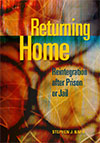 The United States has the highest incarceration rate in the world. In 2013, there were 2.3 million persons in U.S. prisons and jails. Eventually 95% of these people will be released. As of 2013, there are 850,000 persons on parole after release. Yet these people have great difficulty re-integrating back into society. The data shows that within 3 years of release, three-quarters of the released will be rearrested, and half of them will be re-incarcerated. The costs of re-incarceration are high, both in taxpayer dollars and in wasted human potential and in human suffering. What can be done to help the released reintegrate into society and avoid re-incarceration?
The United States has the highest incarceration rate in the world. In 2013, there were 2.3 million persons in U.S. prisons and jails. Eventually 95% of these people will be released. As of 2013, there are 850,000 persons on parole after release. Yet these people have great difficulty re-integrating back into society. The data shows that within 3 years of release, three-quarters of the released will be rearrested, and half of them will be re-incarcerated. The costs of re-incarceration are high, both in taxpayer dollars and in wasted human potential and in human suffering. What can be done to help the released reintegrate into society and avoid re-incarceration?
Social workers and other social service professionals are on the front lines in dealing with what’s known as prisoner re-entry, and they know how formerly incarcerated individuals face enormous challenges in re-entering society, and building lives for themselves. Social workers need tools and data to help them serve the re-entry population. To that end, NASW Press has published Returning Home: Reintegration after Prison or Jail, by Stephen J. Bahr, PhD, a professor of sociology at Brigham Young University.
Bahr begins his book by surveying prevailing social theories that help in understanding the conditions under which former prisoners re-enter society. These include the social learning theory, the social control theory, the life course theory, the strain theory, etc. From this theoretical basis, he then goes on through the remainder of the book to discuss several factors affecting the success or failure of ex-inmates in re-integrating into society:
- Housing
- Employment
- Family
- Friends
- Substance abuse
- Mental health
- Treatments & programs
- Social context
- Age
He looks at what aspects of the factors can help or hinder the former inmates, and fills the book with hard data to back up his assertions. Ultimately, the objective of the book is to understand what helps former inmates reintegrate into society so that this knowledge can be used to help improve programs and policies, and to counteract the disruptiveness the incarceration causes in the lives of former inmates and their families.
As Bahr himself succinctly points out:
The reintegration of offenders is part of a broader societal problem regarding those who are stigmatized and disenfranchised. To reduce crime and recidivism, offenders need help to gain access to opportunities including education, job training, employment, housing, insurance, drug treatment, and medical care. And they need help in distancing themselves from criminal elements in society. The lack of access to legitimate opportunities produces strain that may encourage some to pursue illegitimate opportunities. Thus, parolees are similar to many minorities and immigrants in that they are marginalized and have difficulty accessing legitimate opportunities.
Bahr’s book adds greatly to the study of prisoner re-entry, and provides useful knowledge on how social services can improve the opportunities of former inmates attempting to reintegrate into society.



